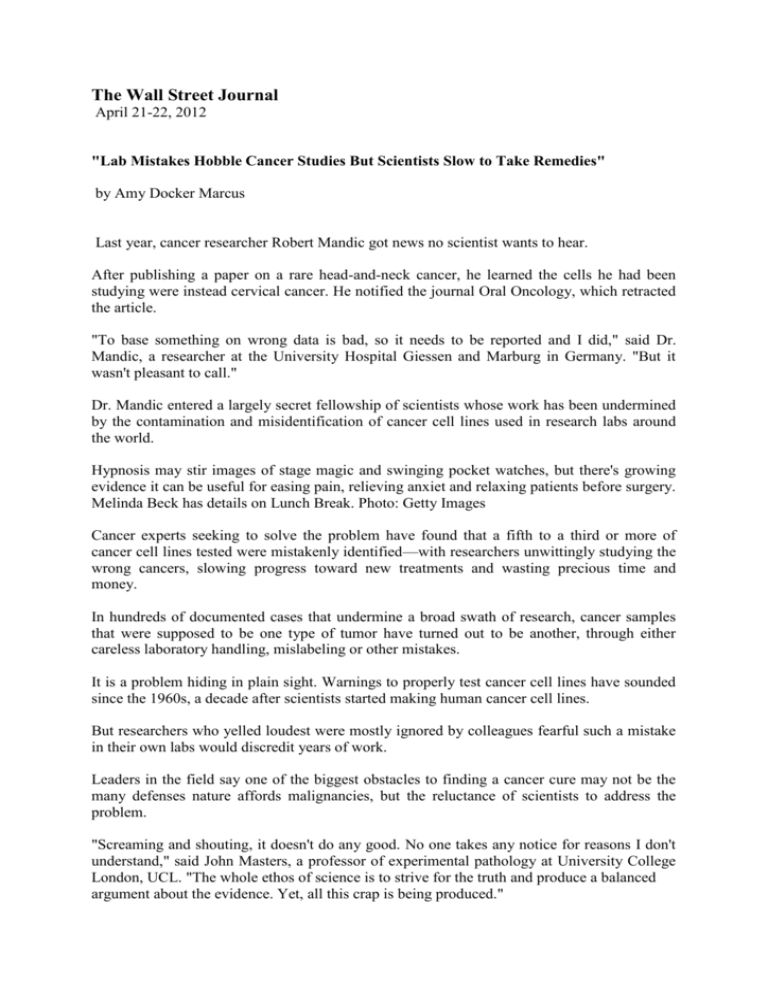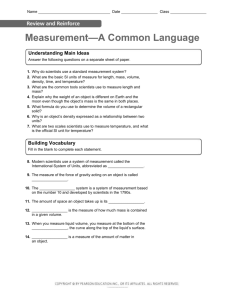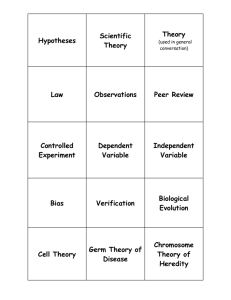
The Wall Street Journal
April 21-22, 2012
"Lab Mistakes Hobble Cancer Studies But Scientists Slow to Take Remedies"
by Amy Docker Marcus
Last year, cancer researcher Robert Mandic got news no scientist wants to hear.
After publishing a paper on a rare head-and-neck cancer, he learned the cells he had been
studying were instead cervical cancer. He notified the journal Oral Oncology, which retracted
the article.
"To base something on wrong data is bad, so it needs to be reported and I did," said Dr.
Mandic, a researcher at the University Hospital Giessen and Marburg in Germany. "But it
wasn't pleasant to call."
Dr. Mandic entered a largely secret fellowship of scientists whose work has been undermined
by the contamination and misidentification of cancer cell lines used in research labs around
the world.
Hypnosis may stir images of stage magic and swinging pocket watches, but there's growing
evidence it can be useful for easing pain, relieving anxiet and relaxing patients before surgery.
Melinda Beck has details on Lunch Break. Photo: Getty Images
Cancer experts seeking to solve the problem have found that a fifth to a third or more of
cancer cell lines tested were mistakenly identified—with researchers unwittingly studying the
wrong cancers, slowing progress toward new treatments and wasting precious time and
money.
In hundreds of documented cases that undermine a broad swath of research, cancer samples
that were supposed to be one type of tumor have turned out to be another, through either
careless laboratory handling, mislabeling or other mistakes.
It is a problem hiding in plain sight. Warnings to properly test cancer cell lines have sounded
since the 1960s, a decade after scientists started making human cancer cell lines.
But researchers who yelled loudest were mostly ignored by colleagues fearful such a mistake
in their own labs would discredit years of work.
Leaders in the field say one of the biggest obstacles to finding a cancer cure may not be the
many defenses nature affords malignancies, but the reluctance of scientists to address the
problem.
"Screaming and shouting, it doesn't do any good. No one takes any notice for reasons I don't
understand," said John Masters, a professor of experimental pathology at University College
London, UCL. "The whole ethos of science is to strive for the truth and produce a balanced
argument about the evidence. Yet, all this crap is being produced."
Dr. Masters said cell banks report that 20% of cell lines sent for inclusion in their repositories
for use by researchers are improperly identified. He was co-chair of an international
committee of scientists that released voluntary guidelines this year to begin solving the
problem. They call for, among other measures, routine profiling of cell lines using a DNA
technique employed in forensics called "short tandem repeats," or STR.
Much of cancer research seeks answers to questions of basic biology, so the proper
identification of cell lines may be less important, said Dr. Masters. But when seeking cancer
treatment for a specific tumor, he said, such mistakes "are an utter waste of public money,
charity money and time."
Worse, he added, "It may be causing drugs to be used which are inappropriate for that
particular type of cancer."
Cancer research relies on cell lines that originate in patient tumors. The cells are usually
grown in plastic containers and, with the proper nutrients, can live indefinitely in a laboratory.
Scientists store them in freezers for years. The cells mimic particular kinds of tumors, giving
researchers a way to understand what drives a disease or to test promising drug treatments.
It may take a year or more to find the right combination of nutrients to keep cancer cells
growing. Once a line is established, scientists often share them with colleagues, who then
grow them in their own labs. The problem is that many scientists don't test the cells when
shipping or receiving a batch.
The most famous and ubiquitous human cancer cell line was the first—an aggressive, fastgrowing cervical cancer taken from Henrietta Lacks of Maryland before her death in 1951. It
has been shared with scientists world-wide in the decades since, playing a broad role in
medical research spanning polio to hemophilia.
The so-called HeLa cells, named for Ms. Lacks, also have taken over other cancer cell lines,
many times unknown to researchers.
These mix-ups are maddeningly difficult to pinpoint: an improperly sterilized pipette, a lab
worker momentarily distracted, a misread label or a typo on a record sheet.
Cell repositories in the U.S., U.K., Germany and Japan have estimated that 18% to 36% of
cancer cell lines are incorrectly identified. Researchers at Glasgow University and CellBank
Australia found more than 360 such mistaken cell lines, including 100 that turned out to be
the late Ms. Lack's cervical cancer cells.
"All of this sharing of cell lines, it's a bit like having unprotected sex," said David Tarin, a
pathologist at the University of California, San Diego.
Dr. Tarin himself is at the center of a lingering debate over the true identity of a famous breast
cancer cell line known as MDA-MB-435.
Dr. Tarin has spent 25 years working with that cell line—or so he thinks. A body of research
suggests that MDA-MB-435 isn't breast cancer; many scientists now believe the cells growing
in labs and used in decades of research are melanoma.
The line originated at the M.D. Anderson Cancer Center in Houston, using cells from a 31year-old woman who died in 1976, less than a year after she was diagnosed. The cell line was
among the most widely used in metastatic breast cancer research.
In 2000, scientists at Stanford University, working in collaboration with the National Cancer
Institute, started testing the 60 cell lines in the institute's permanent collection.
Michael Eisen, then part of the Stanford team, said they found something surprising about the
breast cancer cell line: genes that mimicked melanoma. "It stuck out as problematic," said Dr.
Eisen.
At the time, the scientists didn't suspect contamination. They thought the breast cancer patient
also might have had undiagnosed melanoma.
Other scientists, following up on the observations at Stanford, demonstrated that MDA-MB435 behaved like melanoma because it likely was melanoma—in particular, a skin-cancer cell
line called M14.
As word spread, Michael D. Johnson of Georgetown University Medical Center and a team of
colleagues tested stocks of MDA-MB-435 from their lab and others around world. He said the
group assumed their laboratory cell lines were the "real ones," and that other scientists' lines
had been corrupted. Instead, the group found every one of the cell lines tested was melanoma,
not breast cancer.
Decades of research had been built on insights from research using that cell line. Now, said
Dr. Johnson, "I'm not going to use them to study breast cancer. I don't believe they are breast
cancer."
Dr. Tarin disagrees, citing his own study that showed breast cancer tumors can have
melanoma-like genes.
Increasingly, medical journals won't accept research on breast cancer involving the MDAMB-435 cell line, throwing into question decades of experiments and innumerable published
papers based on the line.
Seeking to solve the problem, a committee led by ATCC, a nonprofit group based in
Manassas, Va., released guidelines this year to establish standards to authenticate cancer cell
lines.
ATCC is working with the National Center for Biotechnology Information, a branch of the
National Institutes of Health, to establish a central repository and database of cell lines that
have undergone genetic testing and whose origins can be verified.
The National Institutes of Health have, so far, not required cell line authentication as a
condition of receiving federal grants. The NIH in 2007 called for more stringent peer-review
when cell lines are used in papers submitted for publication. Journals of the American
Association For Cancer Research now require authors to disclose how and when their cell
lines were tested.
One challenge is getting scientists to acknowledge their cell line is contaminated. The
prevailing attitude, according to researchers, is that the other lab's cell line may be
contaminated but not mine.
Osamu Tetsu, a head-and-neck cancer researcher at the University of California, San
Francisco, did a study in 2009 that concluded all six known cell lines used by researchers
studying adenoid cystic carcinoma were contaminated.
All of the work done on the rare cancer—published papers, research, drug studies—had been
conducted with mislabeled cell lines, Dr. Tetsu concluded. He called the findings
"catastrophic."
Jeffrey Kaufman, executive director of the Adenoid Cystic Carcinoma Research Foundation,
said the group lost about $150,000 on a project that had to be scrapped. He alerted Dr.
Mandic, who had a lab perform STR profiling on his cell line, which came from a colleague,
who got it from another scientist a decade earlier. Tests revealed it was Ms. Lack's cervicalcancer cell line.
The scientist cited in Dr. Tetsu's paper as the source of one of the corrupted cell lines said his
lab wasn't responsible. Ruy Jaeger of the University of São Paulo in Brazil wrote in an email
to The Wall Street Journal that his cell line was, in fact, adenoid cystic carcinoma. He also
pointed out he had not directly provided the line used in the published paper.
Dr. Tetsu said he tested a cell line created from Dr. Jaegar's line by a scientist in the U.S. The
only way to resolve the dispute, said Dr. Tetsu, would be to perform STR profiling of Dr.
Jaegar's cells and compare them to the DNA of the original cancer patient.
The problem is particularly damaging for research into such rare cancers as adenoid cystic
carcinoma, which strikes 1,200 people in the U.S. each year. The lack of a good cell line
slows research and few in the field have the time or resources to create new lines.
More broadly, the sharing of cell lines is such an intrinsic part of scientific culture, Dr. Tetsu
said, that "it is almost impossible to stop."
University of Washington scientist Stanley Gartler warned about the practice in 1966. He had
developed a pioneering technique using genetic markers that would distinguish one person's
cell from another. Using the process, he tested 20 of the most widely used cancer cells lines of
the era. He found 18 of the lines weren't unique: They were Ms. Lacks' cervical cancer.
"People were upset," said Dr. Gartler, who published his findings a year later in the journal
Nature. "No one wants to admit they made a mistake."
Dr. Gartler, an 88-year-old professor emeritus, said a decade after publication of his findings
he attended a conference and introduced himself to a scientist. Dr. Gartler recalled the man
told him, "'I heard your talk on contamination. I didn't believe what you said then and I don't
believe what you said now.' "
That became a long-held view. Nearly 40 years later, Dr. Masters, in a study of scientific
papers published between 2000 and 2004, found nearly a 1,000 citations of the same
contaminated cancer lines revealed in Dr. Gartler's 1966 findings, which have since been
replicated many times using more advanced techniques. "They are either crooks or stupid,"
said Dr. Masters.
Financial donors to cancer research are unaware of the problem, Dr. Masters said, and "it
would be a pity if money stopped going to cancer research" because scientists fail to test their
cell lines, a procedure that costs about $200.
From San Diego, Dr. Tarin wrote to the ATCC to say his studies show that MDA-MB-435 is
a breast cancer line, not melanoma. He has not heard back.
Yvonne Reid, who works for the ATCC and was a member of the committee that wrote the
new guidelines, said, "It is hard to come down for one or the other" without testing tissue
from the breast-cancer and melanoma patients who originated the cell lines.
Donald Morton, who was part of the team at the University of California, Los Angeles that in
the 1980s grew the original melanoma line now believed to have contaminated MDA-MB435, said his cell line has genetic markers that match the original patient with melanoma.
Dr. Morton, currently the melanoma program director at the John Wayne Cancer Institute in
Santa Monica, Calif., said he would share frozen tissue samples from the melanoma patient
with scientists seeking to test against contaminated cell lines.
His melanoma cells, Dr. Morton said, are indeed melanoma.
"What happened after that cell line left my lab," he added, "I cannot say."
Copyright 2012 Dow Jones & Company, Inc. All Rights Reserved
This copy is for your personal, non-commercial use only. Distribution and use of this material are governed by
our Subscriber Agreement <http://online.wsj.com/public/page/subscriber_agreement.html> and by copyright
law. For non-personal use or to order multiple copies, please contact Dow Jones Reprints at 1-800-843-0008 or
visit www.djreprints.com <http://www.djreprints.com>








